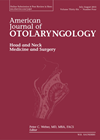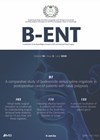
Journal Reviews archive for 2022
A diagnosis-based scoring system to predict outcomes in necrotising otitis externa
Patients admitted with necrotising otitis externa have increased six-fold in the last 10 years. The prognosis is variable and dependent on co-existing morbidities. Charlston Comorbidity Index (CCI) is a weighted comorbidity scoring method, based on the presence or absence of...
Factors influencing transformation of laryngeal dysplasia to malignancy in a 10-year review
Laryngeal dysplasia has a propensity to change into malignancy, the generally reported rate of this being about 14%. In this retrospective study of 125 patients, the authors have assessed the severity of dysplasia in relation to the incidence and time...
Indication and timing of electrodiagnostic tests in facial palsy
This excellent review describes the benefits and limitations of electrodiagnostic testing for patients with facial paralysis. Tests such as Schirmer, stapedial reflex and electrogustometry have been largely replaced by neurophysiologic tests like nerve excitability test (NET), electroneuronography (ENoG), surface electromyography...
Climate change and global health
As we put together the Editors’ Choice for Jul/Aug 2022 Journal Reviews, news from a meeting of the G7 energy and environment ministers has been shared that the G7 countries are to stop public funding of any overseas fossil fuel...
Coblation for laryngeal granulomas
Laryngeal granulomas remain notorious for their tendency to recur after surgical removal. Although high rates of complete remission have been reported with use of the potassium-titanyl-phosphate (KTP) laser, this equipment is expensive and not available in all units performing ENT...
An advance in imaging for sinonasal tumours?
Benign sinonasal growths are incredibly common, and malignant sinonasal growths thankfully rare. We know that malignant tumours often present late, and the imaging can sometimes be misleading, so the authors here compare using diffusion weighted imaging (DWI), dynamic contrast enhanced...
Corticosteroid prescribing in ENT - are we at risk of being sued?
Of medications leading to malpractice claims, corticosteroids comprise the third most common. They are used widely and have a significant side-effect profile: hypertension, lipodystrophy, diabetes, avascular necrosis of the femoral head, peptic ulceration and psychiatric reactions to name but a...
Cochlear implants in the over 80s
The UK has an ageing population. Seven percent of the over 80s population have bilateral severe to profound hearing loss which can lead to associated negative outcomes (social isolation, depression and reduced quality of life). Cochlear implantation (CI) can successfully...
Pharmacological treatment of glue ear in children
Otitis media with effusion (OME), also known as glue ear, is a common cause of hearing loss in children. Most cases resolve spontaneously within three months. Early and proper management of OME can help avoid hearing and speech impairment that...
Cartilage interposition versus PORP ossiculoplasty
In this Egyptian study, the authors looked at the hearing outcomes in patients who underwent ossiculoplasty with cartilage interposition versus those with partial ossicular replacement prosthesis (PORP). They looked at a total of 47 ears from 45 consecutive patients with...
How interaural level differences differ between children with bilateral cochlear implants and their normally-hearing peers
A group in the Netherlands investigated interaural level differences (ILDs) in children who were bilaterally implanted with cochlear implants (CIs) and compared their performance to their normally-hearing peers. ILDs are used to localise sound and rely on the high-frequency cues....
What characterises dysphagia in unilateral vocal fold impairment?
The closure of the vocal folds during swallowing is known to contribute to airway protection along with epiglottic inversion and closure of the false vocal folds. It is therefore plausible to expect that unilateral vocal fold impairment without complete closure...
















